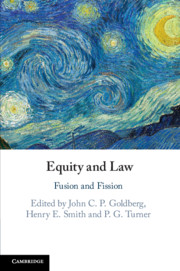Book contents
- Equity and Law
- Equity and Law
- Copyright page
- Contents
- Figures
- Table
- Contributors
- Acknowledgements
- Abbreviations
- Table of Cases
- Statutes
- 1 Fusion and Theories of Equity in Common Law Systems
- Part I Legal Systems and Legal Institutions
- 2 Equity
- 3 The Union of Law and Equity
- 4 What Did the Makers of the Judicature Acts Understand by ‘Fusion’?
- 5 At the Crossroads of Fusion
- 6 Fusion–Fission–Fusion
- 7 Fusion without Fission
- 8 Are Equity and Law in Scotland Fused, Separate or Intertwined?
- Part II Fusion and Fission in Doctrine and Practice
- Part III Functional, Analytical and Theoretical Views
- Index
7 - Fusion without Fission
Equity and the Judicature Acts in Colonial Victoria
from Part I - Legal Systems and Legal Institutions
Published online by Cambridge University Press: 26 July 2019
- Equity and Law
- Equity and Law
- Copyright page
- Contents
- Figures
- Table
- Contributors
- Acknowledgements
- Abbreviations
- Table of Cases
- Statutes
- 1 Fusion and Theories of Equity in Common Law Systems
- Part I Legal Systems and Legal Institutions
- 2 Equity
- 3 The Union of Law and Equity
- 4 What Did the Makers of the Judicature Acts Understand by ‘Fusion’?
- 5 At the Crossroads of Fusion
- 6 Fusion–Fission–Fusion
- 7 Fusion without Fission
- 8 Are Equity and Law in Scotland Fused, Separate or Intertwined?
- Part II Fusion and Fission in Doctrine and Practice
- Part III Functional, Analytical and Theoretical Views
- Index
Summary
When the English Judicature Acts were adopted in Victoria, there was scarcely a need for them. From its establishment, the Supreme Court of Victoria held legal and equitable jurisdiction and little differentiation between law and equity. Indeed, the successful operation of the court before the English Judicature legislation shows how much the success of a court depends on the skill and work of its judges and officers as distinct from its institutional structure. This is shown through a study of the work of Justice Robert Molesworth, who as the principal equity judge for a long period in effect embodied equity in Victoria. His versatility and industry are examined to explain why law and equity operated harmoniously, and why the professional and practical dualism experienced in England – which motivated reform – was absent from Victoria. Hence the inutility of the Judicature Act reforms later introduced in Victoria.
Keywords
- Type
- Chapter
- Information
- Equity and LawFusion and Fission, pp. 144 - 178Publisher: Cambridge University PressPrint publication year: 2019

